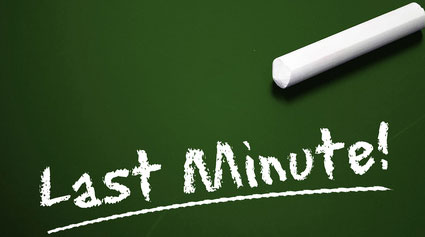May tends to be one of the most popular SAT testing months, so we’re safely assuming that stress levels of juniors across the country are steadily rising as the May 5th SAT draws closer. Most of our students at Y.E.S. have been preparing since March, but we’re realistic enough to know that not all students have begun this early. It’s not too late to review some essential content areas and strategies, though. Today, we’re sharing our two-week SAT prep plan for all those students who have yet to begin studying for the test.
STEP ONE: LEARN THE FORMAT
There’s nothing worse than going into an exam not knowing what you’re going to be tested on or how long you’re going to have to solve problems. Familiarizing yourself with the SAT is one of the best steps you can take to ensure you feel more confident in the testing room. We’ve provided a quick overview below, but you can find a more comprehensive view “Inside the Test” on CollegeBoard’s website.
- READING | 65 minutes | 52 Questions | 5 Passages (1 Literary Narrative; 2 Social Science; 2 Natural Sciences)
- To effectively pace yourself in this section, plan on spending approximately 2 minutes skimming each passage and 11 minutes answering questions.
- WRITING | 35 minutes | 44 Questions | 4 Passages
- You’ll have approximately 8.5 minutes to complete questions for each passage, which contain 11 questions each. Check your time after the second passage: if it’s been more than 17 minutes since you began this section, you’ll need to pick up the pace.
- MATH NO CALCULATOR | 25 minutes | 20 questions (15 multiple choice, 5 free response)
- Plan on spending about 1 minute per question on this section, and having a little bit of time left over for more challenging problems. Questions increase in difficulty on both math sections.
- MATH CALCULATOR | 55 minutes | 38 questions (30 multiple choice, 8 free response)
- You’ll have closer to 1.5 minutes per question on this section. Again, problems increase in difficulty as you get further into the test, so you’ll want more time saved up for the second half of the section.
STEP TWO: REVIEW ESSENTIAL CONTENT AREAS
With only two weeks left until test day, it would be virtually impossible to review every topic you’ll face on the SAT. However, the test makers do have some “favorite” content areas that we’d suggest reviewing, particularly for the math sections. Use the information and links below to practice over the next 14 days.
- READING: The passages that typically feel least familiar to students are the Natural Science ones, presumably because they’re filled with dense language and advanced concepts that students have rarely covered in class. We recommend reading only the first and last paragraphs in full for these passages, and only reading the first sentence of every other paragraph. This will allow you to skip the “heavy stuff” that might slow you down and/or lead to unnecessary confusion. When answering questions, begin with questions that provide references to specific lines or paragraphs, and save main idea or inference questions for last. Pages 8-10 of this SAT practice test provide a great example of a typical SAT science passage. Answers can be found here.
- WRITING: This section tests students on both grammar and rhetorical skills. We’ve found that by the time students are in high school, English courses focus more on critical analysis and writing than on strict rules of grammar. Therefore, we’d suggest reviewing these rules, starting with punctuation. Begin with this quick and straightforward review. Once you’ve mastered this, take a look at a complete Writing section on pages 18-21 of the practice test included above to familiarize yourself with more types of questions.
- MATH NO CALCULATOR: Of the 20 questions included in this section, nine of them come from the “Passport to Advanced Math” category. This is essentially CollegeBoard’s fancy way of saying “quadratic equations, radicals and exponents.” Prepare to tackle these problems by reviewing factoring, foiling, and working with polynomial expressions. Prep Scholar’s “Three Key Strategies for SAT Passport to Advanced Math” post is a great place to start.
- MATH CALCULATOR: Percentages, ratios, and proportions rule this section. Students MUST understand how to calculate percentages (and percent increases and decreases), set up ratios and proportions, and convert data into various units of measurement. Khan Academy provides helpful videos that walk through examples of these types of problems here, here, and here.
STEP THREE: PREPARE NECESSARY TEST-DAY MATERIALS
Preparation is all in the details, and you want to guarantee you have these all covered. On the day of the test, you’ll need a few essentials items:
- Ticket
- Photo ID
- Number 2 pencils (with good erasers!)
- Approved Calculator (see policy here)
- Water and snack for break (students will take a break after the Writing section and before the Essay section if they are taking this portion)
Notice that we didn’t include a phone on this list? We always suggest leaving your phone at home or in your car. If you absolutely must bring it into the testing center, turn it off. No silent mode, no airplane mode, and definitely no vibrate mode. Just turn it off.
We’re wishing all testers the best of luck with the May SAT. Happy studying!
Y.E.S.


